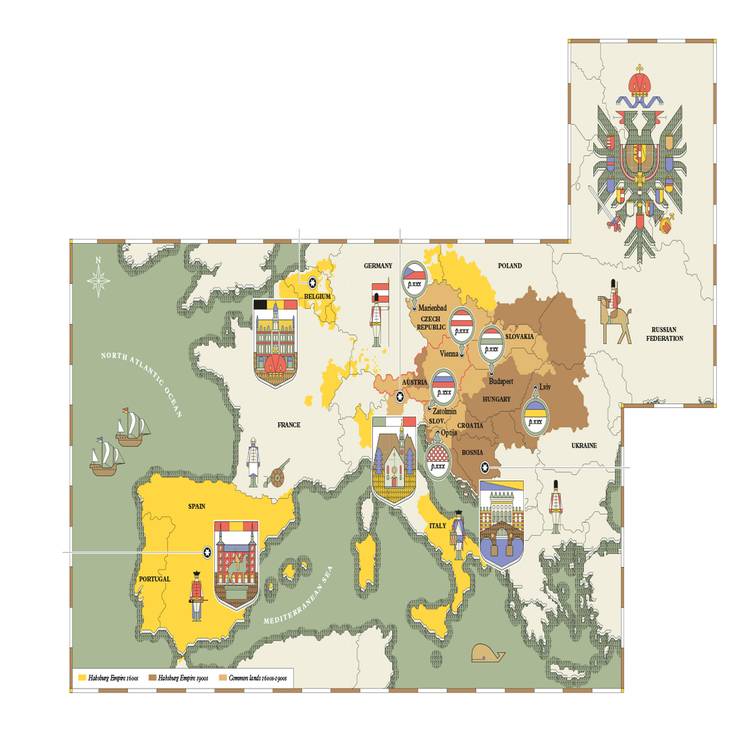History / Europe
Power points
The mighty Habsburg empire helped to shape the cities, sights and stories of much of present-day Europe. We map four cross-continental sites where its impact has been felt most keenly, from the splendour of its Iberian outposts to its fateful final days in the Balkans.

Madrid
Thanks to its ornate buildings, manicured public gardens and pretty plazas, Madrid is one of Europe’s most beautiful capitals. Add in hot days and warm nights, a lively street culture and residents known for their bonhomie, and you have a city with a distinctly Spanish soul. But its emergence as a European capital can, in part, be attributed to Austrian influence. Madrid became one of two Habsburg capitals when the empire was divided after the death of Charles V. Felipe II (Philip II), one of his sons, was handed the empire’s western portion and set his court here in the 1560s. The Habsburg’s rule coincided with Spain’s golden age, an era of economic success resulting from the country’s colonial expansion. The kings at this time spent their wealth on buildings and infrastructure projects, many of which remain key to Madrid.
The city’s historic centre goes by the name of El Madrid de los Austrias and the most notable Habsburg construction, Plaza Mayor, lies at its hub. Laid out in 1619, the huge plaza has nine entrances, a corridor of arcades, red-brick façades and pointed towers. Further Austrian influence is found in the Ministerio de Asuntos Exteriores, while important Habsburg-era religious buildings also dot the area. Convento de las Carboneras was founded in 1605 and its cloistered nuns still make and sell biscuits here. Next to Iglesia San Jerónimo El Real is the Prado Museum, in which you can look a Habsburg in the eye in Titian’s portrait of Carlos V (Charles V).
Low Countries
Brussels: the political heart of a pan-European union of states struggling to stay together as nationalist factions fight for power. It sounds like a summary from today’s newspapers but it also applies to the reign of Charles V, Holy Roman emperor from 1519 to 1556 and inheritor of the Habsburg throne. To people in the Low Countries, however, he was known as Carolus V and was very much one of their own. Born in the Flemish city of Ghent and brought up in Mechelen, Charles V set up court in Brussels. With Spanish and Austrian empires to rule, he spent much of his time on the road, though the Brussels tourism authority claims that the city was his main place of residence and keeps his legacy alive with the annual Carolus V festival. The highlight is the Ommegang pageant, a procession marking the first visit of Charles V to his Low Countries capital with his son and future king, Phillip II.
Up in the Netherlands they weren’t too keen on Phillip II and rebelled against the distant Spanish king. But the link has nevertheless crept into festive folklore: the Dutch Sinterklaas arrives by boat from Spain every November to distribute presents, before returning to the old ruler, sometimes with some naughty children in his sack.
South Tyrol
The pretty towns and villages of Italy’s South Tyrol are hard to distinguish from Austria. They dot an alpine landscape in which 62 per cent of the population share the same German dialect as Innsbruck and Kitzbühel. Unlike other parts of the multicultured Habsburg empire that fell away after the First World War, this region, ceded to the Italians by the allies, has always been just so, well, Austrian. Italianisation policies under the fascist regime of the 1920s – when the use of German was outlawed, even in private – doubtless led to deep resentment. Today there is still a small (and very occasionally violent) contingent of separatists who call for reunification with Tyrol north of the border. However, most battles nowadays are more semantic in nature. The very name of the autonomous region is a source of contention: the Italian “Alto Adige” is unanimously shunned (even reviled) by German speakers, who call it “Südtirol”.
Defining the identity of this unique, truly Mitteleuropean region is difficult. Ask one of its younger citizens, who will likely be bilingual or trilingual (with perfect English thrown in), if they feel Austrian or Italian and the standard retort is: “Neither, I’m South Tyrolean.”
Sarajevo
It all ended for the Habsburgs in Bosnia-Herzegovina, where the assassination of Archduke Franz Ferdinand and Duchess Sophie in 1914 made Sarajevo infamous. It deprived Austria-Hungary of its heir and pushed Europe towards war. Within five years the empire was no more.
Reminders abound in modern Sarajevo. The Latin Bridge over the Miljacka River once carried the name of the assassin, Gavrilo Princip, and has a museum at one end. The Franz and Sophie tea shop and Franz Ferdinand Hostel are nearby, while a walking tour picks out key sites. But the Habsburgs’ architectural legacy is more impressive and includes the glorious Vijecnica (city hall) with its striped, neo-Moorish façade. All but destroyed in 1992 during the Balkan wars, it reopened in 2014 after a painstaking restoration, just in time for the centenary of the First World War.


